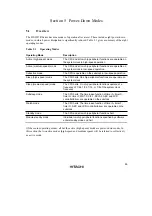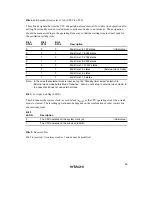
106
5.3.4
Standby Mode Transition and Pin States
When a SLEEP instruction is executed in active (high-speed) mode or active (medium-speed)
mode while bit SSBY is set to 1 and bit LSON is cleared to 0 in SYSCR1, and bit TMA3 is
cleared to 0 in TMA, a transition is made to standby mode. At the same time, pins go to the high-
impedance state (except pins for which the pull-up MOS is designated as on). Figure 5.2 shows
the timing in this case.
SLEEP instruction fetch
Internal data bus
Fetch of next instruction
Port output
Pins
High-impedance
Active (high-speed) mode or active (medium-speed) mode
Standby mode
SLEEP instruction execution
Internal processing
ø
Figure 5.2 Standby Mode Transition and Pin States
5.3.5
Notes on External Input Signal Changes before/after Standby Mode
1. When external input signal changes before/after standby mode or watch mode
When an external input signal such as
IRQ
or
WKP
is input, both the high- and low-level
widths of the signal must be at least two cycles of system clock ø or subclock øSUB (referred
to together in this section as the internal clock). As the internal clock stops in standby mode
and watch mode, the width of external input signals requires careful attention when a transition
is made via these operating modes. Ensure that external input signals conform to the conditions
stated in 3, Recommended timing of external input signals, below
2. When external input signals cannot be captured because internal clock stops
The case of falling edge capture is illustrated in figure 5.3
As shown in the case marked "Capture not possible," when an external input signal falls
immediately after a transition to active (high-speed or medium-speed) mode or subactive
mode, after oscillation is started by an interrupt via a different signal, the external input signal
cannot be captured if the high-level width at that point is less than 2 t
cyc
or 2 t
subcyc
.
3. Recommended timing of external input signals
To ensure dependable capture of an external input signal, high- and low-level signal widths of
at least 2 t
cyc
or 2 t
subcyc
are necessary before a transition is made to standby mode or watch
mode, as shown in "Capture possible: case 1."













































